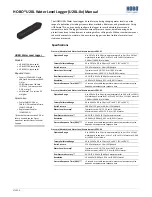
HOBO U20L Water Level Logger (U20L-0x) Manual
1-800-LOGGERS 4
www.onsetcomp.com
1.
Follow the instructions that came with your base station or
shuttle to attach it to a USB port on the computer.
2.
Unscrew the black plastic end cap from the logger by
turning it counter-clockwise.
Note:
If the logger has been
deployed, there may be water in the end cap. This is
normal; this water will not penetrate the waterproof seal
around the communications window in the logger.
3.
Attach the coupler to the base station or shuttle.
4.
Insert the logger into the coupler so that the alignment
bump on the logger slides into the alignment bump on the
coupler. Be sure it is properly seated in the coupler. It may
take a few seconds for the new hardware to be detected by
the computer.
NOTE
: If you are using the Waterproof Shuttle, briefly press the
coupler lever to put the shuttle into base station mode.
If the logger has never been connected to the computer before,
it may take a few seconds for the new hardware to be detected
by the computer.
WARNING
: Do not leave the logger in the coupler for extended
periods of time. When connected to a coupler, the logger is
“awake” and consumes significantly more power than when it
is disconnected and considered “asleep.” Always remove the
logger from the Optic Base Station or HOBO Waterproof Shuttle
as soon as possible after launching, reading out, or checking the
status to avoid draining the battery. To “wake up” the logger,
remove it from the coupler, wait a moment and then re-insert
the logger.
Launching the Logger
Before deploying the HOBO U20 Water Level Logger in the field,
perform the following steps in the office:
1.
Open HOBOware.
2.
Connect the logger to the computer as described in the
previous section.
3.
From the Device menu, select Launch.
4.
In the Launch Logger window, make sure both the Abs.
Pressure and Temperature sensors are selected
(temperature is required for temperature compensation of
pressure).
5.
Select any other launch settings as desired, including when
to start logging and the logging interval. Click the Start
button in the lower right corner of the Launch Logger
window to send the launch settings to the logger (note that
the Start button text changes based on the Start Logging
selection).
Deploying the Logger
The HOBO Water Level Logger is designed to be easy to deploy
in many environments. The logger uses an absolute pressure
sensor, so no vent tube is required. The small size of the logger
is convenient for use in small wells and allows the logger to be
mounted and/or hidden in the field. Follow these guidelines
when deploying the logger:
•
The pressure sensor is temperature compensated over the
range of 0° to 40°C (32° to 104°F). To obtain the highest
level of accuracy, the logger should be allowed to come to
full temperature equilibrium (approximately 20 minutes)
before the reference level is recorded.
•
Sudden temperature changes should be avoided. When
deploying a HOBO U20L Water Level Logger for barometric
pressure reference, some consideration should be made to
minimize the rate of temperature fluctuations. Ideally, the
barometric pressure reference logger should be hung
several feet below ground level in an observation well
where ground temperatures are stable (while making sure
the logger remains above the water level). If that is not
possible (or if a well is not used), try to put the logger in a
location where it will not be subject to rapid daily
temperature cycles.
•
When deploying a HOBO Water Level logger in a well,
make sure the well is vented to the atmosphere. Typically,
a small hole can be drilled in the well cap to ensure that
the pressure inside and outside the well is at equilibrium.
If this is not possible, the barometric pressure reference
logger should be used inside the same well.
•
Use a no-stretch wire to hang the water level logger. Any
change in length of the wire will result in a 1-to-1
corresponding error in the depth measurement. Always
pull-test a cable prior to deploying a logger in a well to
make sure it does not stretch.
•
If you are deploying the logger in a lake, river, or stream,
you must first build a stilling well to protect the logger
from vibration, shock, and movement. A simple stilling
well can be constructed with PVC or ABS pipe. A properly
constructed stilling well helps to protect the logger from
currents, wave action, and debris. Suspend the logger in
the stilling well so it is always underwater, but not on the
bottom to be buried by silt.
For more information, see the Technical Application Note
for Constructing a Stilling Well at:
http://www.onsetcomp.com/water_level_stilling_well.html
•
To prevent the logger from moving in currents and to
ensure the support cable is kept straight during
deployment, you may need to add a weight to the
suspension cable or hang a weight below the logger.
Align the bump on the logger
with the bump on the coupler
To base station
or shuttle
Coupler
Logger
Coupler lever (for use with
HOBO Waterproof Shuttle
End cap








